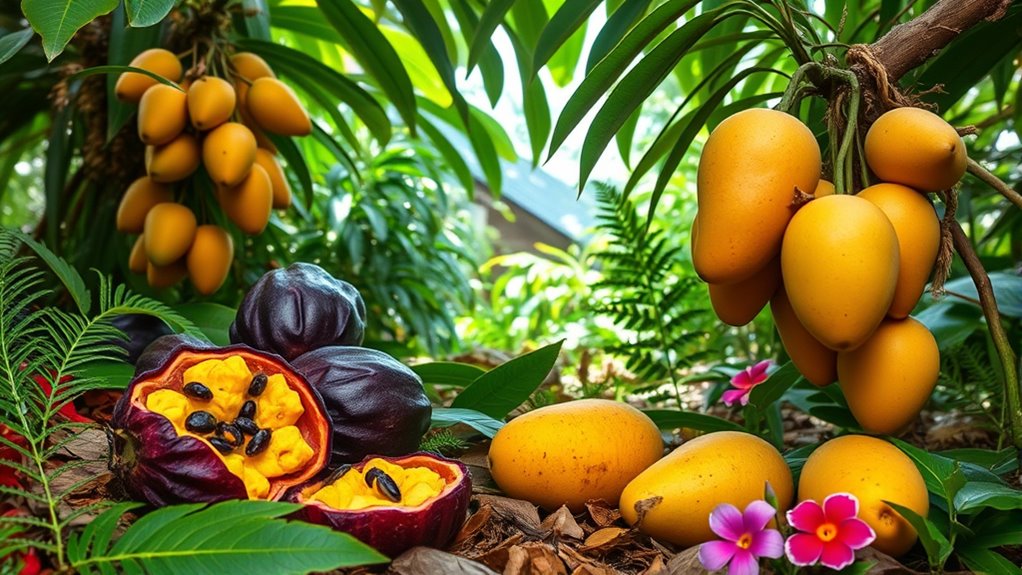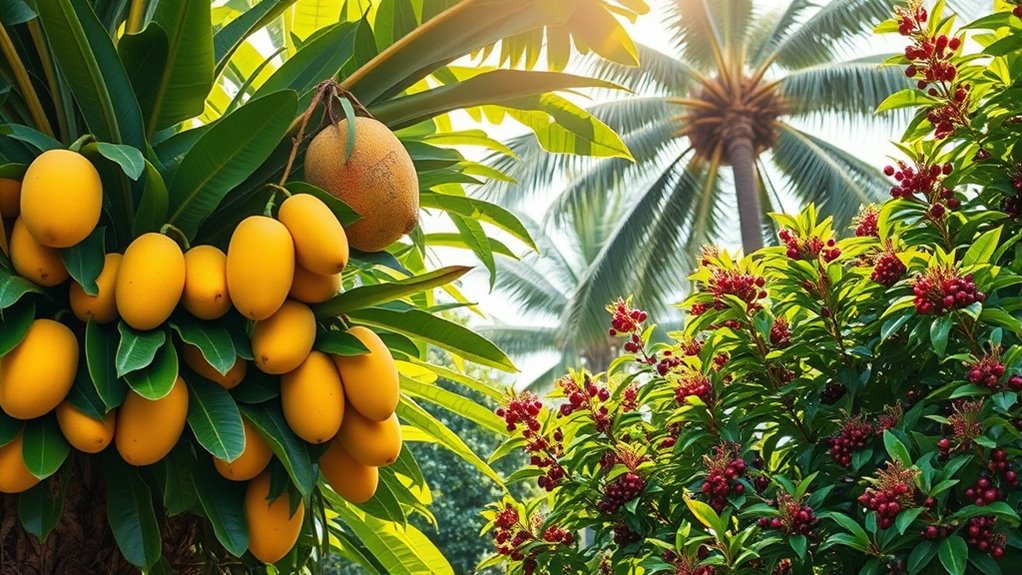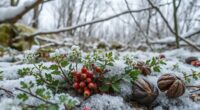In warm climates, you can forage a variety of tropical fruits like mango, guava, passionfruit, and lychee, known for their sweet flavors and nutritional benefits. You’ll also find edible plants like pineapple weed, water spinach, and wild herbs that mimic exotic tastes. Proper identification, sustainable harvesting, and safety precautions are essential for successful foraging. To explore these vibrant options and learn how to do it responsibly, keep exploring this guide.
Key Takeaways
- Tropical foraging includes edible fruits like mango, guava, lychee, and passionfruit, as well as native greens such as water spinach and lemongrass.
- Proper identification of plants and look-alikes ensures safe foraging and avoids toxic species like Oleander or Doll’s Eyes.
- Sustainable harvesting practices, including selective picking and respecting plant health, help preserve ecological balance.
- Edible plants mimicking tropical flavors, like pineapple weed and cleavers, expand culinary options in warm climates.
- Foraged tropical ingredients support biodiversity, enhance local diets, and promote environmental stewardship.
Exploring Tropical Edible Fruits and Their Unique Flavors

Tropical edible fruits offer a vibrant palette of flavors that thrive in warm climates, making them an exciting discovery for foragers. These tropical fruits, like pineapple, guava, passionfruit, and lychee, are known for their distinctive, sweet, and aromatic flavor profiles. You’ll notice unique combinations, such as the strawberry guava’s blend of strawberry, cherry, and lemon, or the floral sweetness of lychee. Many edible plants also produce flavors reminiscent of exotic fruits, like grapefruit-like notes from Douglas fir or pineapple hints from pineapple weed. These fruits are not only flavorful but often packed with vitamin C and antioxidants, offering both taste and health benefits. Exploring tropical plants for foraging reveals an array of exotic, enticing flavors that elevate your culinary experiences.
Edible Plants That Mimic Exotic Fruits in Warm Environments

Many plants in temperate gardens offer flavors that closely resemble exotic fruits, allowing for a tropical taste experience without leaving your climate. Edible plants like pineapple weed, wood sorrel, and bramble shoots mimic tropical flavors such as pineapple, apple, and coconut, providing an exotic taste in a temperate climate. Douglas fir offers a grapefruit-like flavor, perfect for syrups and teas, resembling tropical citrus fruits. Cleavers produce a juice reminiscent of unripe green bananas, adding a tropical banana note to woodland foraging. These plants deliver tropical flavors—pineapple, coconut, banana, and grapefruit—without needing exotic climates. However, proper identification and moderation are essential, as some of these edible plants can be harmful if misused or misidentified. Vetted – Mother Baby Kids with proper foraging, you can enjoy a tropical flavor palette right in your backyard. Additionally, understanding edible plants that mimic tropical fruits can enhance your foraging experience and ensure safety. Exploring foraging safety tips can help prevent accidental ingestion of toxic look-alikes, making your tropical foraging both enjoyable and safe. Being aware of the impact of cookies on user experience can also help you navigate online resources about edible plants more effectively. Furthermore, knowledge of UV exposure and skin protection is valuable when foraging outdoors to keep your skin safe from the sun.
Recognizing and Harvesting Tropical Plants Safely

To forage safely, you need to confidently identify tropical plants by examining key features like leaf shape, flowers, and fruit. Be alert for toxic look-alikes that resemble edible species, and always double-check before harvesting. Practice sustainable harvesting by taking only what you need and ensuring plants can continue to grow. Additionally, understanding celebrity lifestyle insights can inspire sustainable and responsible foraging practices in eco-friendly environments.
Accurate Plant Identification
Accurate plant identification is essential when foraging in tropical environments to guarantee safety and avoid toxic look-alikes. You must verify Latin names and distinctive plant features before harvesting. Using reputable field guides, plant identification apps, or consulting local experts helps ensure correct identification of edible plants in your region. Focus on unique plant features like leaf shape, flower structure, fruit appearance, and growth habitat to distinguish safe options from poisonous ones. Seasonal changes can alter how plants look, so keep this in mind. It’s also helpful to understand self watering plant pots as they can be used to cultivate identified edible species safely at home, ensuring proper moisture levels for healthy growth. Proper identification minimizes risks and helps you confidently forage for safe, nourishing tropical plants. Additionally, understanding unique and wicked planters and plant care tools can assist in cultivating identified edible species safely at home. Developing an awareness of personality traits through self-understanding can also enhance your ability to choose suitable plants based on your lifestyle and preferences. Recognizing the importance of curiosity can encourage you to explore new plants and expand your foraging knowledge, leading to safer and more successful harvesting endeavors. Being familiar with Glycolic Acid benefits can help in selecting appropriate skincare for post-foraging skin care routines, especially when exposed to sun and environmental elements.
Recognizing Toxic Look-Alikes
Recognizing toxic look-alikes is crucial for safe foraging in tropical environments, as some poisonous plants closely resemble edible species. Accurate plant identification helps prevent dangerous mistakes, especially when toxic plants like Doll’s Eyes or Oleander mimic safe options. Look for specific features, such as Doll’s Eyes’ black-dotted berries or the hood-shaped flowers of Monkshood, to distinguish deadly plants from edible ones. Many poisonous look-alikes contain potent toxins—aconite in Monkshood or glycosides in Wisteria—that can cause severe illness or death if misidentified. Always verify plant identity with multiple reliable sources before harvesting, and avoid plants with unfamiliar or suspicious features. Recognizing these toxic plants is essential to avoid accidental poisoning and ensure a safe foraging experience. Incorporating effective fraud prevention tools during identification processes, such as detailed documentation and verification procedures, can further reduce the risk of misidentification. Paying attention to plant features can significantly improve your accuracy when identifying tropical species. Additionally, understanding the importance of emotional alignment can help gather clearer insights during the identification process, reducing confusion and potential errors. Being aware of specific plant toxins and their effects can further enhance your safety during foraging expeditions.
Safe Harvesting Practices
When harvesting tropical plants, it’s vital to verify their identity with multiple trusted sources to avoid mistaking toxic look-alikes for safe species. Proper plant identification helps prevent poisoning and guarantees safety during foraging. Use sharp tools and harvest only mature, healthy parts of plants, which supports sustainability and plant health. Be cautious of plants growing near roadsides, polluted areas, or heavily trafficked zones, as they may absorb toxins or contaminants. Wearing gloves when handling unknown plants reduces skin irritation and absorption risks. Practice moderation by sampling small quantities first and waiting for any adverse reactions before consuming larger amounts. Remember, safe harvesting practices protect both your health and the environment, making your tropical foraging experience both enjoyable and sustainable.
Foraging Tips for Identifying Tropical and Subtropical Species

To identify edible tropical and subtropical species, start by recognizing key features like leaf shape, flower structure, and fruit characteristics. Always consult reliable field guides and botanical resources to confirm your identifications. Be cautious of look-alike plants by verifying details through multiple sources before harvesting.
Recognize Key Plant Features
Identifying tropical and subtropical plants relies heavily on observing their distinctive features, which serve as visual clues for accurate recognition. Focus on leaf shape, arrangement, and texture; for instance, passionfruit vines have glossy, elliptical leaves, while prickly pear cacti display spiny cladodes. Carefully examine flower structures—wisteria’s bell-shaped, fragrant blooms or zinnias’ star-shaped flowers help confirm species. The growth habit is also key; distinguish between climbing vines, shrubs, or trees, such as upright loquats versus sprawling passionfruit. Recognizing these key features allows you to differentiate plants confidently and avoid mistakes. Additionally, understanding architectural solutions can aid in identifying plants suited for specific environments and purposes. Recognizing characteristic leaf arrangements is essential, as it provides quick visual confirmation of a plant’s identity, especially when flowers or fruit are not yet in season. Paying attention to plant texture can also help distinguish species, as some have rough, smooth, or fuzzy surfaces that are unique to particular plants. Furthermore, observing growth patterns can provide additional clues, since some species exhibit distinctive habits like bushiness or trailing growth. Incorporating knowledge of water-loving plants can further enhance your ability to identify species that thrive in moist environments.
Use Reliable Identification Guides
Using reliable identification guides is a key step in accurately recognizing tropical and subtropical plants. Invest in detailed field guides with high-quality photographs and clear descriptions to improve your plant identification skills. Cross-reference multiple reputable sources, such as regional foraging books and botanical databases, to confirm plant identities before consuming anything. Focus on learning key features like leaf shape, flower structure, fruit characteristics, and growth habits specific to tropical species. Be mindful of look-alike plants—both edible and toxic—and note subtle differences in color, size, and habitat to avoid confusion. Prioritize foraging safety by verifying identifications carefully, testing small quantities first, and avoiding plants from polluted or contaminated areas. Accurate identification is essential for safe, confident foraging.
Beware of Look-Alike Species
Beware of look-alike species, as many edible tropical and subtropical plants have toxic or inedible counterparts that can easily be mistaken for the real thing. Misidentifying plants can lead to serious health issues or fatalities. For example, the Deadly Amanita mushrooms resemble edible varieties but cause about 90% of mushroom fatalities worldwide. Similarly, Oleander flowers emit a sweet scent but are highly toxic if ingested. Fruits like Horse Nettle look like edible tomatoes but contain poisonous berries and spines. To avoid danger, always verify plant species with reliable guides or experts. Proper plant identification is essential to prevent confusion with look-alikes that may pose toxicity risks. Always double-check before consuming any unfamiliar plant to stay safe in your foraging adventures. Additionally, understanding the distinctive features of safe versus toxic plants greatly reduces the risk of accidental poisoning.
Common Tropical Trees and Shrubs for Edible Harvesting

Tropical regions abound with a variety of trees and shrubs that offer reliable, nutritious harvests with minimal effort. When foraging, you’ll find that tropical trees like mango, papaya, and guava produce abundant edible fruits that thrive in warm climates. Trees such as loquat and pomegranate are hardy in hot, dry conditions and yield nutrient-rich fruits perfect for eating fresh or preserving. The citrus family—including oranges, lemons, and limes—flourish in full sun, adding flavor and medicinal value to your harvests. Tropical nut trees like coconuts, cashews, and macadamia provide high-protein nuts and oils, supporting your diet. Shrubs such as Lilly Pilly and Feijoa produce easy-to-harvest berries and fruits, diversifying your foraging options in tropical environments.
Wild Herbs and Greens for Tropical and Warm Climates

Wild herbs and greens thrive in warm, humid environments, providing a rich source of nutrients and flavor for foragers. You’ll find plenty of wild greens like amaranth, water spinach, and taro leaves, which are essential for local diets. Edible herbs such as wild sorrel, purslane, and wild lettuce are abundant, offering vitamins, minerals, and antioxidants. Tropical plants like lemongrass, kaffir lime leaves, and Thai basil grow wildly and add authentic flavor to dishes. However, proper identification and preparation are indispensable since some greens, like certain ferns or nightshades, can be toxic if misused. The diversity of wild herbs and greens supports food security and culinary variety, especially in indigenous diets. Mastering these wild greens enhances your foraging skills and culinary repertoire through mindfulness.
Seasonal Availability of Tropical Forage Plants

The availability of forage plants in tropical regions varies markedly throughout the year, influenced by seasonal weather patterns and regional climates. During late spring to early fall, many tropical fruits like mangoes, papayas, and guavas are seasonally abundant, offering fresh options for foraging. Tropical plants such as passionfruit, lychee, and durian have specific fruiting seasons that peak with regional climatic cycles, ensuring ideal flavor and nutrition. Some wild edible plants like coconut and betel leaves are available year-round, while others like jackfruit and breadfruit have distinct fruiting seasons. Seasonal rainfall greatly impacts flowering and fruiting periods, with some plants producing multiple crops annually in monsoon areas. Coastal zones often provide more consistent access to certain tropical plants throughout the year.
| Plant Type | Fruiting Season |
|---|---|
| Mangoes | Late spring to early fall |
| Passionfruit | Specific regional cycles |
| Lychee | Seasonal, varies by region |
| Coconut | Year-round |
| Jackfruit | Distinct seasonal periods |
Sustainable Practices When Foraging in Warm Regions

To guarantee sustainable foraging in warm regions, it’s essential to harvest only mature, abundant, and naturally fallen fruits and plants. This approach helps prevent overexploitation and supports healthy ecosystems. Practice rotational foraging to allow plant populations to recover, maintaining biodiversity. Use selective harvesting methods, like removing only parts of plants or a few fruits, to minimize disturbance and encourage regrowth. Familiarize yourself with native plant populations and seasonal cycles to avoid damaging rare or vulnerable species. Additionally, steer clear of invasive plants and avoid disrupting habitats. By adopting these sustainable practices, you protect edible plants and ensure that foraging remains a beneficial activity for the environment. Responsible foraging in warm regions sustains both local ecosystems and your access to diverse, nutritious resources.
Using Tropical Foraged Plants in Culinary and Herbal Preparations

Using tropical foraged plants in your culinary and herbal creations offers a vibrant way to enjoy their natural flavors and benefits. You can transform edible plants like pineapple weed, wood sorrel, and bramble shoots into delightful dishes and beverages. Incorporate tropical fruits such as passionfruit, feijoa, and citrus into herbal teas, syrups, or desserts for a fresh, natural taste. Edible flowers like zinnia and wisteria add colorful garnishes or flavorings to salads, baked goods, and drinks. Wild nuts like coconuts and macadamia nuts provide rich textures for snacks or oils. Proper identification and preparation are essential to safely access their culinary potential and maximize flavor.
| Edible Plants | Flavors & Uses | Culinary Applications |
|---|---|---|
| Pineapple weed | Pineapple aroma | Teas, garnishes |
| Wood sorrel | Apple-like acidity | Salads, drinks |
| Bramble shoots | Fruity, tart | Desserts, snacks |
Frequently Asked Questions
What Is the 1 3 Rule for Foraging?
The 1-3 rule for foraging says you should only take about one-third of any wild plant or fruit. This way, you leave enough behind for the plant to grow again and support local wildlife. It also helps you avoid overharvesting and reduces the risk of consuming toxins or allergens. Following this rule keeps foraging sustainable, safe, and respectful of nature’s balance.
What Is the Golden Rule of Foraging?
The golden rule of foraging is to always positively identify plants before eating them. You should use reliable guides or consult experts to distinguish safe, edible plants from toxic look-alikes. Remember to forage responsibly by harvesting only what you need, respecting local laws, and avoiding uncertain or wild mushrooms, which can be deadly if misidentified. Following this rule keeps you safe and helps protect the environment.
Is Foraging Illegal in the US?
You wanna know if foraging is illegal in the US, right? It depends. While some areas allow recreational foraging on public land, others strictly prohibit it, especially in national parks and protected zones. Always check local laws first because private landowners can also restrict foraging. Violating these rules can lead to fines or legal trouble. So, be sure to research and get permission before collecting plants or fruits.
What Not to Eat When Foraging?
When foraging, you shouldn’t eat wild plants or mushrooms unless you’re sure they’re safe. Avoid plants with bad odors or those growing near roads, as they might be polluted. Never consume berries, seeds, or leaves from poisonous plants like Oleander or Doll’s Eyes. Stay away from wild fungi unless an expert confirms they’re edible, and be cautious of plants containing cyanide, like plum flowers or certain seeds.
Conclusion
As you explore the vibrant world of tropical foraging, remember that each plant is a gift from nature’s bounty waiting to be uncovered. With careful harvesting and respect for the environment, you can reveal a treasure trove of flavors and remedies that nourish both body and soul. Embrace this journey like a gentle dance with nature, where every find is a reminder of the wild, beautiful symphony thriving in warm climates.










